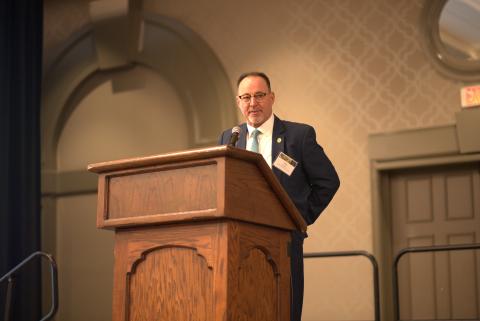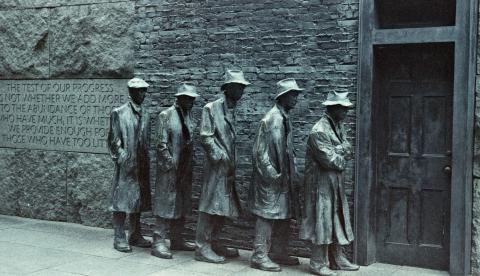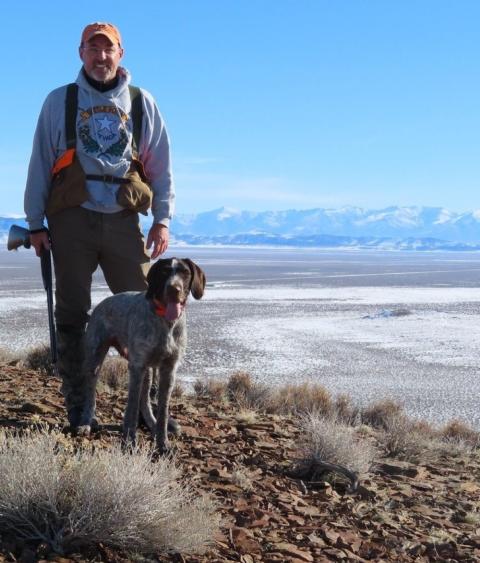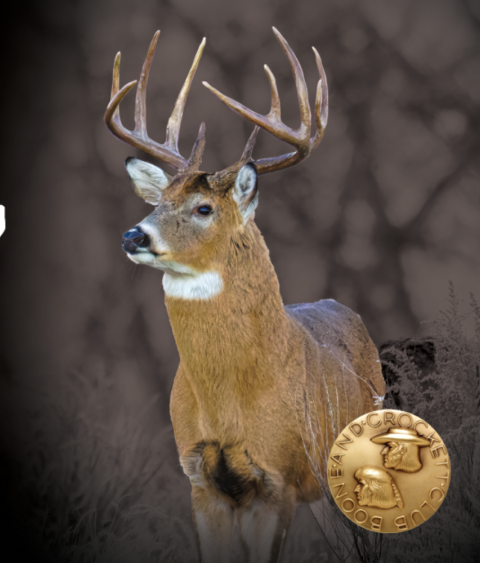Breadcrumb
- Home
- Outdoor News Bulletin
- June 2025
- Foundations of Conservation: 1930 American Game Policy
Outdoor News Bulletin
Foundations of Conservation: 1930 American Game Policy
Adapted from Tony Wasley’s remarks during the Special Session The Foundation of Conservation is Cracked at the 90th North American Wildlife and Natural Resources Conference in March 2025
Is the foundation of conservation cracked? Presently, it’s certainly under duress. There are some significant fissures beginning to show but before we can answer that question, we need to identify what we mean by the term foundation. What really constitutes conservation’s foundation? What are the elements that shape our conservation views and drive our conservation priorities? Where did they come from? Everything that we build rests on these foundations, and every now and then there comes a time that when enough change happens, it warrants a pause, a purposeful reflection, and a reassessment of where we are, how we got here, and for us to ask ourselves if there is a need for adaptation or an evolution of our approaches.

I once heard that conservation had a reflection deficit disorder. Our failure to reflect on our past often limits our ability to learn from—and benefit from—the work of those who came before us.
Similarly, I’ve heard it said that the past is a place for reflection and not residence.
Foundational Elements
In this special session, we took a purposeful look back through the lens of conservation’s history and the opportunities that often arose from the chaos in order to imagine the art of the possible for conservation’s future.
Our ultimate goal is to identify and define, from our relatively short history, a set of key “foundational elements” that remain relevant today. We hope this will provide us a basis to build conservation’s future, allow us to add new and emerging approaches, and assist in unifying us in our efforts and outcomes. We seek elements that have been created and have evolved through practice and experimentation.
As we explore conservation’s history and imagine conservation’s future, we also need to contemplate our conservation capacity. How is the conservation workforce and capacity generated as the result of the New Deal in the 1930s different from today and the rapid contraction of government conservation capacity we are currently experiencing?
There exist several relevant touchstones in our relatively young field of conservation, and this special session and series in the Outdoor News Bulletin walk through several of these touchstones in a chronological order. Not only will we spend time exploring the specific contents of these touchstones, but we will also explore the conditions and attitudes of the day.
In last month’s ONB, Charlie Booher discussed the specific historic event and efforts surrounding the Boone and Crockett Club’s Fair Chase Ethic of 1888 and Theodore Roosevelt’s “Conservation as a National Duty” speech from 1908. This month we will examine the 1930 American Game Policy and next month the 1973 North American Wildlife Policy. Each of these “statements of intent” are being explored with respect to their contents, origins, and what unique conditions happened within each era, that may have affected their creation, content, and existence.
And finally, in a future ONB, we will take a look at where we are today, how that might be different than other eras, and what challenges or opportunities might exist given our current conditions.
1930 American Game Policy
How many have heard of the 1930 American Game Policy? How many have actually read the policy and if so, how many have read it in the last year? Admittedly, it was a document that entered my professional wildlife career late. Despite the tardiness however, since it’s arrival it has featured prominently in my thoughts and I’m hoping to share with you many of the reasons why that is the case.
Before diving too deeply into the policy, I really want to set the stage of the 1930s. The context of what happened during the 1930s, both immediately before the policy was shared as well as everything that transpired after its completion, is relevant.
Although the policy is called the 1930 American Game Policy it was actually written in 1928, before the stock market crash of 1929. However, the simple fact that the policy was still advanced in 1930 after the stock market collapse and at the beginning of the Great Depression underscores its importance at the time.
It’s hard to determine cause and effect related to the proliferation of conservation-related activities in the 1930s but I will say that it is without question one of the two busiest periods of time for the creation of conservation-related policy and associated activity in our modern history.
Just a quick overview, and at the risk of missing someone or something, let’s take a quick look at the 1930s.
A short list of accomplishments includes:
- 1930 American Game Policy,
- 1933 Aldo Leopold writes Game Management,
- 1933 Civilian Conservation Corps and Tennessee Valley Authority are created,
- 1934 Duck Stamp Act and the Fish and Wildlife Coordination Act,
- 1935 the Fish and Wildlife Cooperative Research Units and the Soil Conservation Service are formed,
- 1937 Pittman Robertson Act is passed and Ducks Unlimited, The Wildlife Society, and National Wildlife Foundation are founded,
- And, in 1939 the Bureaus of Fisheries and Biological Survey are moved to the Department of the Interior and the following year on June 30, 1940, they become the US Fish and Wildlife Service.
Enough? Holy cow! Is that a productive decade or what?
All Despite Extreme Social Conditions
But what gets even more interesting to me are the social conditions under which it all occurred. As I’ve already said, the stock market took a huge tumble on Black Tuesday, with stockbrokers literally jumping to their death out of Wall Street high rises. It was the beginning of the Great Depression which officially began in 1933.
Oh yeah, there was the Dust Bowl too that stretched from 1930 to 1936 but really peaked in 1934 and 1935.
The economy was in the tank. Natural resources were stressed and strained. Unemployment in 1933? 25%! Peak unemployment during the 2008 recession was 10% and unemployment during COVID peaked at 14.8%
Many people lost their homes and savings. Schools were overcrowded and underfunded and many children worked in order to support their families.
The social attitudes of the time included Isolationism and desired to avoid involvement in European and Asian conflicts, anti-communism, and there was a significant conservative shift.
Additionally, there were 200 million fewer people in the United States in 1930 than today—123 million in the US in 1930 and 323 million today; 2 billion people in the world in 1930 and over 8 billion today.
So, in 1928 when Aldo Leopold sat down with a committee of 13 others, they had no idea what lay ahead. They simply stated that the “present order is radically unsatisfactory” and began to articulate their policy.
Overarching Themes
Several overarching themes exist throughout the policy and those most obvious to me include coexistence, cooperation, compromise, and humility.
The coexistence specifically references different and unique values and perspectives, perhaps none clearer or earlier than on the first page where the committee makes every effort to dispel the notion that economic enterprise and wildlife conservation are mutually exclusive.
The economic enterprise most often referenced in the policy are those of forest and farm. It clearly states in the introduction that the committee contends that the two can and should co-exist, each on its appropriate kind of land, and often in close proximity to each other.
The committee repeatedly speaks to the collective beneficiaries of conservation drawing specific reference to the sportsman, nature-lover, conservation officer, farmer, lumberman, stockman, educator, and biologist and the need for cooperation.
The authors acknowledge the need for balance between program priorities to reflect conservation as a whole, and the need for “harmonious cooperation,” knitting together the landowner, the sportsman, and the public
Compromise isn’t called out specifically but is obviously described in several places. Much like the thoughts and philosophies around the Fair Chase Ethic that had been put forward by the Boone and Crockett Club 40 years prior, many of the day knew that “the conduct and character” of the hunter mattered for the continuation of the heritage. In one particular reference in discussing protection vs management, the authors on Leopold’s committee noted that if in fact, protection was a sure way to secure the abundance of game and it came at the expense of hunting, “half a loaf was better than none.”
Humility is evident throughout the policy, and the authors were sure to make note early and often that the policy wasn’t perfect—it could be improved and needed further experimentation, and they invited discussion and encouraged refinement. They specifically noted their inability to predict a detailed system far in advance and stated that experiment not doctrine or prophecy is the key to an American Game Policy.
Seven Fundamental Actions
With these several overarching themes and many more subtle themes, the policy put forward by Leopold’s committee included seven “fundamental actions”:
- Extend public ownership and management of game lands just as far and fast as land prices and available funds permit. The authors went as far to say, “the recreational value of the remaining wilderness is far greater than its economic value; that it should be acquired by the federal government or the states and permanently dedicated to those special forms of outdoor recreation requiring a wilderness environment.” The also encouraged acquisition of winter range to balance summer range
- Recognize the landowner as the custodian of public game on all other land. In short, make game management a partnership enterprise to which the landowner, the sportsman, and the public each contribute to appropriate services, and from which each derive appropriate rewards.
- Experiment
- Train men (people) for skillful game administration, management, and fact finding. Make game a profession like forestry, agriculture, and other forms of applied biology
- Find facts on what to do on the land that would make game abundant
- Recognize the non-shooting protectionist and the scientist as sharing with sportsmen and landowners the responsibility for conservation of wildlife as a whole. Insist on a joint conservation program, jointly formulated and jointly financed.
- Provide funds. Insist on public funds from general taxation for all betterments serving wildlife as a whole. Let sportsmen pay for all betterments serving game alone. Seek private funds to help carry the cost of education and research.
In a brief review of the current status of the seven fundamental actions, it is clear significant progress has been made. Simple categorization of the actions according to their level of realization looks something like this:
Jointly formulated and jointly financed game management programs, public funds from general taxation for betterments serving wildlife as a whole.
Sportsmen pay a portion though Pittman-Robertson and hunting license fees, landowner relations.
Make game management a profession, find facts, organization of departments, Wilderness Act of 1964, continental system of refuges, diversion laws (“in no case should the sportsman tolerate the diversion of a single dollar of state game license funds for general state purposes”) seven years before Pittman-Robertson was passed with consistent language, Cooperative Research Units (university capacity, fact finding, and need for trained professionals). And way before the North American Waterfowl Management Plan (NAWMP) and Fall Flights, in 1928 Leopold’s committee expressed that, “Land purchases to prevent drainage of Canadian breeding grounds, and control of nesting mortality on them, are international betterments deserving of international financing and support.”
Other Notes of Interest
Regarding migratory species, the committee wrote, “the extreme mobility of migratory species diffuses the penalties of local abuse, and the rewards of local care, over the whole continent.”
With respect to salaries they wrote, “It is idle to expect efficiency from any form of organized state leadership unless the salary scale is comparable to that of an industrial enterprise of like magnitude. Few governors receive what capable directors of conservation ought to get.”
On the topic of funding, they asserted, “We believe that the public should help bear those costs which affect the public interest.” Expressing that many of the sportsman-funded betterments “do not benefit shootable game alone nor sportsman alone. They benefit wildlife as a whole and the public as a whole. They are public betterments, and hence proper as general treasury liabilities.”
On the need for better public education they wrote, “The public now knows of only one way to conserve game: restrictive legislation.”
Several overarching themes exist throughout the policy and those most obvious to me include coexistence, cooperation, compromise, and humility.
In 1928 at the time of this writing, Leopold’s committee estimated that 6% of the population in America hunted.
And finally, where an entire page was dedicated to the topic, the committee offered perspective on what they referred to as a controversial issue: predator control. They offered seven standards to achieve “greater harmony among conservationists and sounder predator control practice by agencies.”
Key Takeaways
The fundamental actions humbly put forward by Leopold’s committee in 1930 provide a great collection of thoughts and considerations for the future of wildlife conservation. Many of the key principles still exist today and many of the committee’s recommendations have come to fruition. Much of this work occurred prior to the chaos that existed during the time recommendations were adopted, but it certainly appears to have set the stage in shaping the future and what we have today.
Many of these fundamental actions remain relevant and worthy of reaffirmation today, some may require modernization, and others not mentioned by Leopold’s committee may need to be added.
To see how Durward Allen picks up where the 1930 game policy left off as well as the conditions, attitudes, and opinions of that era, check back in next month’s ONB.





